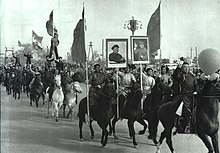
Back Säuberung der Inneren Mongolei German Incidente de Mongolia Interior Spanish Uusi Sisä-Mongolian kansan vallankumouksellinen puolue Finnish Purge de Mongolie-Intérieure French Insiden Mongolia Dalam ID Incidente della Mongolia Interna Italian 内モンゴル人民革命党粛清事件 Japanese Incidente da Mongólia Interior Portuguese 内人党事件 Chinese
| Inner Mongolia Incident | |
|---|---|
| Part of Cultural Revolution in China | |
 The establishment of the revolutionary committee in Inner Mongolia (1967) | |
| Native name | 内人党事件 |
| Location | Inner Mongolia, China |
| Date | 1967 1967 – 1969 |
| Target | Ethnic Mongols, alleged former members of the Inner Mongolian People's Revolutionary Party (PRP), "separatists" and Enemies of the Chinese Communist Party |
Attack type | Political repression, mass murder, mass arrests and abuse |
| Deaths | 16,222-100,000 |
| Injured | 81,000 |
| Victims | 1,000,000+ (accused or persecuted) |
| Perpetrators | Chinese Communist Party, People's Liberation Army, Teng Haiqing |
| Motive | Cultural Revolution instigated by Mao Zedong, elimination of political enemies, persecution of ethnic minorities, prevention of political independence |
| Inner Mongolia incident | |||||||
|---|---|---|---|---|---|---|---|
| Simplified Chinese | 内人党事件 | ||||||
| Traditional Chinese | 內人黨事件 | ||||||
| |||||||
| Inner Mongolia People's Revolution Party purge incident | |||||||
| Simplified Chinese | 内蒙古人民革命党肃清事件 | ||||||
| Traditional Chinese | 內蒙古人民革命黨肅清事件 | ||||||
| |||||||
The Inner Mongolia incident, or the Inner Mongolia People's Revolutionary Party purge incident (Chinese: 内人党事件; pinyin: Nèi rén dǎng shìjiàn), was a massive political purge which occurred during the Cultural Revolution in Inner Mongolia.[1][2] The purge was supported by the Central Committee of the Chinese Communist Party and was led by Teng Haiqing, a lieutenant general (zhong jiang) of the People's Liberation Army.[2][3] It took place from 1967 to 1969 during which over a million people were categorized as members of the already-dissolved Inner Mongolian People's Revolutionary Party (PRP), while lynching and direct massacre resulted in the deaths of tens of thousands, most of whom were Mongols.[1][2][4][5][6][7][8]
According to the official complaint from the Supreme People's Procuratorate in 1980 after the Cultural Revolution, during the purge, 346,000 people were arrested, 16,222 people were persecuted to death or killed directly, and over 81,000 were permanently injured and disabled.[1][4][5][8][9][10] Other estimates have put a death toll between 20,000 and 100,000, while hundreds of thousands were arrested and persecuted, and over a million people were affected.[2][4][5][7][8][9][11][12]
After the Cultural Revolution, the purge was regarded as a "mistake" and its victims were rehabilitated by the Chinese Communist Party (CCP) during the "Boluan Fanzheng" period, but the commander of the purge, Teng Haiqing, received no trial or legal punishment at all because the Central Committee of CCP thought he had made achievements during the wars in the past.[1][2][5][13][14] On the other hand, some of Teng's affiliates received various terms of imprisonment, with a main Mongol affiliate sentenced to 15 years in prison.[8]
- ^ a b c d Hao, Weimin. "十年浩劫中的内蒙古" [Inner Mongolia during the ten-year havoc]. Xinhuanet (in Chinese). Archived from the original on 4 December 2018. Retrieved 5 December 2019.
- ^ a b c d e Brown, Kerry (1 July 2007). "The Cultural Revolution in Inner Mongolia 1967–1969: The Purge of the "Heirs of Genghis Khan"". Asian Affairs. 38 (2): 173–187. doi:10.1080/03068370701349128. ISSN 0306-8374. S2CID 153348414.
- ^ Hyer, Paul; Heaton, William (1968). "The Cultural Revolution in Inner Mongolia". The China Quarterly. 36 (36): 114–128. doi:10.1017/S0305741000005634. ISSN 0305-7410. JSTOR 652198. S2CID 153537245.
- ^ a b c Song, Yongyi (25 August 2011). "Chronology of Mass Killings during the Chinese Cultural Revolution (1966–1976)". Sciences Po. Retrieved 5 December 2019.
- ^ a b c d Bai, Yintai. "内人党"冤案前后". Chinese University of Hong Kong (in Chinese). Archived from the original on 12 August 2022. Retrieved 5 December 2019.
- ^ Phillips, Tom (11 May 2016). "The Cultural Revolution: all you need to know about China's political convulsion". The Guardian. ISSN 0261-3077. Retrieved 5 December 2019.
- ^ a b Ba, He (25 January 2003). "文革[内人党]事件窥探". Beijing Spring (北京之春). Retrieved 4 December 2019.
- ^ a b c d Ba, Yantai. 挖肃灾难实录 (PDF) (in Chinese). Southern Mongolian Human Rights Information Center.
- ^ a b Yang, Jishen (4 July 2017). 天地翻覆: 中国文化大革命历史 (in Chinese). 天地图书.
- ^ "Inner Mongolia in 'War-Like State'". Radio Free Asia. 5 June 2011. Retrieved 5 December 2019.
- ^ "China Holds Ethnic Mongolian Historian Who Wrote 'Genocide' Book". Radio Free Asia. Retrieved 5 December 2019.
- ^ Unger, Jonathan (18 January 2019). "Turmoil at the Grassroots in China's Cultural Revolution: A Half-Century Perspective". Made in China Journal. Retrieved 5 December 2019.
- ^ Qi, Zhi (26 November 2019). 中华学人论文集——文化大革命50年(1–4): 文献与综述(一) (in Chinese). Remembering Publishing, LLC. ISBN 978-1-951135-05-8.
- ^ 《乌兰巴干案卷》内蒙政法委会议记录, May 1987 (in Chinese)